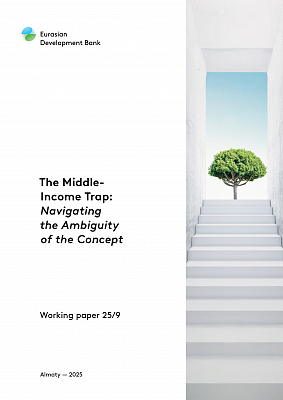The middle-income trap: navigating the ambiguity of the concept

This working paper presents the results of a study entitled “The middle-income trap: navigating the ambiguity of the concept”. This “trap” is a situation in which an economy joins the group of middle-income countries and then finds it difficult for a long time to move into the high-income group.
The concept of the “trap” is relevant to all countries where the EDB operates. Russia and Kazakhstan are close to the threshold that separates middle-income from high-income economies. For these countries, understanding the policy measures that support sustained economic growth is crucial to securing their position among high-income nations. For other countries in the region, identifying such measures is also important, as it can help them avoid falling into the middle-income trap in the future.
Key findings:
- There are many definitions of the “trap.” Among them, three main approaches stand out: qualitative, absolute quantitative, and relative quantitative.
- Whether an economy is in a “trap,” and how serious the challenges it faces are, depends on how the “trap” is defined.
- The factors influencing the transition between income groups depend only weakly on the definition used. Therefore, measures that help avoid falling into the “trap” can be implemented regardless of the nuances of its definition.
- To identify these factors, we conducted an econometric analysis of data for 132 countries for the period from 1960 to 2020.
- Factors influencing the likelihood of moving to a higher income group:
- Creating favourable macroeconomic conditions, including sustained low inflation.
- Maintaining public debt at a moderate level.
- Enhancing investment attractiveness; attracting both domestic and foreign investment.
- Developing innovative potential and human capital through education.
- Improving the quality of public institutions.
- Supporting stable demographic dynamics.
The “middle-income trap” remains a useful concept for discussing the challenges of economic development and can help inform the design of economic and social policy. However, given the absence of a universally accepted definition, caution is warranted when labelling economies as “trapped.”
Structure of the working document: introductory section. A study of the development of leading middle-income economies between 2004 and 2023 through the prism of various definitions of the “trap.” An econometric study of the factors that influence the probability of transitioning between income groups. Conclusion. Appendices describing the data and results of econometric estimates.
